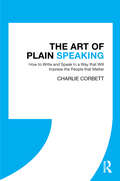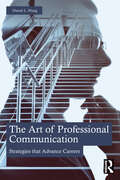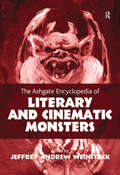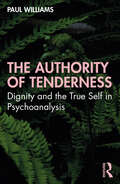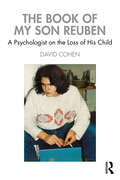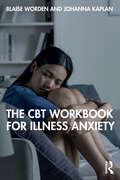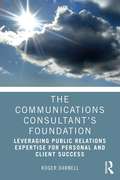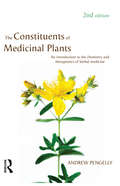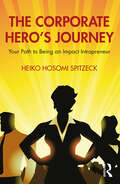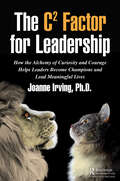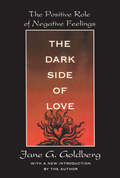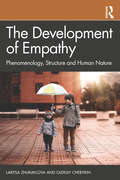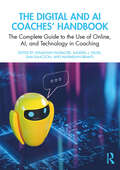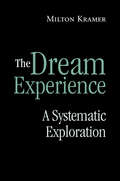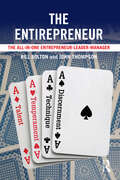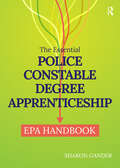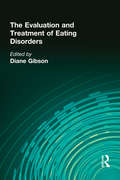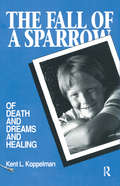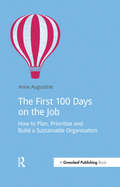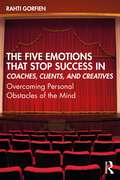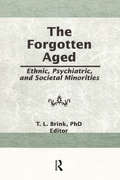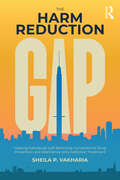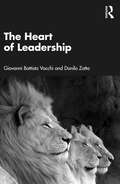- Table View
- List View
The Art of Plain Speaking: How to Write and Speak in a Way that Will Impress the People that Matter
by Charlie CorbettThis is a guide for anyone who wants to connect better with people in the workplace by speaking clearly and with purpose. It is a result of five years at Charlie Corbett’s consultancy, Bullfinch Media, where he helped convince executives that speaking plainly, thoughtfully, and behaving with humanity, is the best way to win business, boost morale and advance careers. It provides carefully detailed wisdom on how to write well, speak publicly and stand out in your job, as well as how to craft compelling communications, make the best of social media and handle the press. The Art of Plain Speaking aims to improve the experience faced by many in the modern workplace, a world where senior management are entirely absent from the shop floor – replaced by indecipherable emails from HR – and where people speak in esoteric corporate riddles, believing that sounding clever is more productive than speaking clearly.
The Art of Professional Communication: Strategies that Advance Careers
by Daniel PlungGoing beyond the mechanics of professional communication, this book combines insights into the overlooked implicit demands of corporate communication challenges with the proven strategies and techniques that distinguish professionals as capable communicators and candidates for promotion.The practical strategies offered in this book represent professional communication principles filtered through the lens of the author’s 40-year career, that enabled him to rise from an initial assignment as a technical editor to positions of senior management directing large, diverse business and technical organizations. Here, he has collected into one resource the reasoned and disciplined decision-making processes, tools, and techniques essential to craft communications, precisely attuned to the explicit and implicit expectations of each assignment and supported by a structure and presentation logic that delivers a totally responsive and accurately targeted product. This is an essential guide for all levels of professionals who recognize the need to distinguish themselves within a highly competitive career environment.Business professionals and instructors in corporate training programs, supervisors and managers, and students in professional communication programs will welcome this deep dive into the real-world challenges and opportunities in professional communication and the role effective communication plays in career advancement.
The Ashgate Encyclopedia of Literary and Cinematic Monsters
by Jeffrey Andrew WeinstockFrom vampires and demons to ghosts and zombies, interest in monsters in literature, film, and popular culture has never been stronger. This concise Encyclopedia provides scholars and students with a comprehensive and authoritative A-Z of monsters throughout the ages. It is the first major reference book on monsters for the scholarly market. Over 200 entries written by experts in the field are accompanied by an overview introduction by the editor. Generic entries such as 'ghost' and 'vampire' are cross-listed with important specific manifestations of that monster. In addition to monsters appearing in English-language literature and film, the Encyclopedia also includes significant monsters in Spanish, French, Italian, German, Russian, Indian, Chinese, Japanese, African and Middle Eastern traditions. Alphabetically organized, the entries each feature suggestions for further reading. The Ashgate Encyclopedia of Literary and Cinematic Monsters is an invaluable resource for all students and scholars and an essential addition to library reference shelves.
The Authority of Tenderness: Dignity and the True Self in Psychoanalysis
by Paul WilliamsThis insightful and beautifully written work explores nonlinear processes of recovery of the loss of Self. The inherent healing power of hard-earned, wholehearted self- acceptance is conceived through the authority of tenderness. The book is the final volume in The Fifth Principle trilogy (the second book being Scum), which chronicled, through the course of one boy’s lifetime, the methods of a mind which is not a mind, in its efforts to prevail under oppressive circumstances. The Authority of Tenderness comes at the end of the journey, is written by the adult self of the child, and uses poetic vignettes, references to foundational psychoanalytic literature and analyses of critical treatment situations to convey the experiences of someone who has been both patient and analyst. The book offers a vivid psychotherapeutic perspective for clinicians, trainees, students and general readers alike.
The Book of My Son Reuben: A Psychologist on the Loss of His Child
by David Cohen"I wish I had not had to write this book because then my lovely son Reuben would still be alive," says David Cohen. "He was adorable, formidably intelligent, a loving son, a loving brother. He died far too young. He had the bad luck to have two grandparents who had addictive personalities. His efforts to resist the lure of drugs failed. And so did I." The Book of My Son Reuben is a personal account of how psychologist David Cohen coped – and did not cope – with the death of his son, Reuben. Offering a unique perspective on the experience of parental loss, it offers a personal and analytical exploration of sorrow and guilt, and of what research tells us about trauma and grief. Illustrated throughout with David Cohen’s personal insight into how he continues to navigate his loss, this honest book provides a deeper understanding of loss for parents who have experienced it, as well as those who support them. The book remembers the many parents who have lost children throughout history and chapters weave personal perspectives with the latest research. It examines the experience of sudden deaths, the failures of society in preventing children from dying, the role of social media, how the loss of a child impacts fathers, siblings and relationships, and the usefulness – or otherwise – of bereavement therapies. A tribute to Reuben’s life, this sensitive volume is for those who have experienced loss and want to gain better understanding of their experience, as well as psychologists, psychotherapists and counsellors working with families.
The CBT Workbook for Illness Anxiety
by Johanna Kaplan Blaise WordenThis cognitive behavioral therapy (CBT) workbook is a detailed, step-by-step account of how to do scientifically supported treatment with adults experiencing illness anxiety.Written by two practitioners with years of specialized training and expertise in CBT for anxiety, this book provides a comprehensive overview of illness anxiety disorder and an exposure-based framework to target fear and avoidance. Detailed exercises and homework are included throughout, as well as charts, diagrams, and a relapse prevention plan. This workbook aims to give illness anxiety sufferers the skills needed to work through the therapeutic journey in decreasing anxiety and beginning recovery.This book is essential for those with illness- or health-related anxiety looking to do self-help or to use with therapists in sessions, along with practicing clinicians who need specialized guidance.
The Coaches' Handbook: The Complete Practitioner Guide for Professional Coaches (Wiley-blackwell Handbooks In Organizational Psychology Ser.)
by Jonathan PassmoreThis comprehensive practitioner guide provides an accessible evidenced based approach aimed at those new to coaching and who may be undertaking coach training for a certificate in coaching or professional credentials or accreditation with the AC, ICF, EMCC, CMI or ILM. The book will also be useful for those who want to enhance their coaching skills. The Coaches Handbook is edited by Jonathan Passmore, an internationally respected expert and executive coach, with chapters from leading coaching practitioners from across the world. The book is divided into seven sections. Section one examines the nature of coaching, its boundaries, the business case for coaching and how organisations can build a coaching culture. Section two focuses on deepening our self-understanding and understanding our clients, the non-violent communications mindset and the coaching relationship. Section three focuses on the key skills needed for coaching including goal setting, powerful questions, active listening, using direct communications and the role of silence, emotions and challenge in coaching. Section four offers a range of coaching approaches including behavioural, person-centred, solution-focused, psychodynamic, neuroscience, narrative, positive psychology, out-door eco-coaching, team coaching, careers coaching and integrated coaching. Section five focuses on fundamental issues in coaching such as ethics and contracting and evaluation. Section six explores continuous professional development, reflection and the role of supervision, as well as how to establish your coaching business. The final section contains a host of coaching tools which practitioners can use to broaden their practice. Unique in its scope, this key text will be essential reading for coaches, academics and students of coaching. It is an important text for anyone seeking to understand the best practice approaches that can be applied to their coaching practice, including human resources, learning and development and management professionals, and executives in a coaching role.
The Communications Consultant’s Foundation: Leveraging Public Relations Expertise for Personal and Client Success
by Roger DarnellFor all professionals and students who want to improve their prospects in business, this book prepares and positions them to build dream careers, giving them the education and guidance required to develop vital soft skills, and work remotely and independently. After establishing a foundation for solid professional communications on a personal level, it quickly opens doors to business insights and opportunities that are exciting, inspiring, and highly sustainable. Immersing readers into the key realms of business success and exploring the full spectrum of essential communications practices, they gain knowledge and trade skills of immense value, including: • The basics of positive, proactive, strategic communications for individuals and organizations • What it means to be a PR expert in the creative industry and to do great work • An introduction to essential business imperatives, with high-level instruction on creativity, strategy, leadership, management, marketing, and much more • Customer service and all it entails • Extensive exploration of the PR toolset and its application in real-world marketing scenarios This book brings home all instruction with sophisticated questions and challenges, ensuring readers have every opportunity to comprehend and grow, step by step.
The Constituents of Medicinal Plants: An introduction to the chemistry and therapeutics of herbal medicine
by Andrew PengellyPengelly's user friendly text will encourage educators in medical science to consider using this material in the complementary medicine/nutraceuticals areas May I congratulate Andrew Pengelly for writing this text as it is going to be very popular with undergraduate students as well as more experienced readers.'D. Green, London Metropolitan University, UKThis unique book explains in simple terms the commonly occurring chemical constituents of medicinal plants. The major classes of plant constituents such as phenols, terpenes and polysaccharides, are described both in terms of their chemical structures and their pharmacological activities. Identifying specific chemical compounds provides insights into traditional and clinical use of these herbs, as well as potential for adverse reactions. Features include: * Over 100 diagrams of chemical structures* References to original research studies and clinical trials * References to plants commonly used throughout Europe, North America and Australasia.Written by an experienced herbal practitioner, The Constituents of Medicinal Plants seriously challenges any suggestion that herbal medicine remains untested and unproven, including as it does hundreds of references to original research studies and trials.Designed as an undergraduate text, the first edition of this book became an essential desktop reference for health practitioners, lecturers, researchers, producers and anyone with an interest in how medicinal herbs work. This edition has been extensively revised to incorporate up-to-date research and additional sections, including an expanded introduction to plant molecular structures, and is destined to become a classic in the literature of herbal medicine.
The Corporate Hero's Journey: Your Path to Being an Impact Intrapreneur
by Heiko Hosomi SpitzeckImpact intrapreneurs at some of the most powerful organizations in the world are designing new, more sustainable businesses from within. They put their values to work and transform their corporations into a force for good. In a corporate world that still largely prioritizes profit above all else, these people shine a light on how to balance profit with impact, and the inspirational stories captured in this book guide leaders and managers to do the same.The lack of purpose beyond profit is causing millions of people to question their work and even to leave the corporate world altogether. Companies are struggling with recruitment and retention, as people seek a greater sense of purpose. For many, this would mean finding a way to use their work as a platform for positive social and environmental impact. This book will inspire this change for leaders seeking a different and better way forward. Structured around the stages of Joseph Campbell’s hero’s journey – upon which Star Wars was based – this book combines the philosophy of Star Wars with inspiring stories of impact intrapreneurs. You’ll get to know Corporate Jedi such as Susie Lonie and Nick Hughes, who, while working for Vodafone in Kenya introduced a mobile payment method which brought financial inclusion to millions; Myriam Sidibé at Unilever, who turns making soap into saving lives; and Gib Bulloch, founder of Accenture Development Partnerships, which provides first-class consulting services to NGOs leveraging their impact. With actionable advice, such as how to create a business case, how to measure social impact, and more, the book is not only an entertaining read, but also helps executives apply insights to their own daily work.Written for leaders, managers, and all professionals looking to create positive impact through their work, this book will give future Corporate Jedi the courage and tools to use the force of business for good.
The C² Factor for Leadership: How the Alchemy of Curiosity and Courage Helps Leaders Become Champions and Lead Meaningful Lives
by Joanne Irving, Ph.D.Packed with nuggets of wisdom from the experiences of champion-level leaders across industries, Dr. Irving demonstrates how champion leaders engage their curiosity and courage to learn from the past, enhance the present and anticipate the future. —Marshall Goldsmith, #1 New York Times bestselling author of Triggers, Mojo, and What Got You Here Won’t Get You There and Thinkers 50 #1 Executive Coach Curiosity and courage are unstoppable forces. In this insightful book, Joanne Irving deftly shows how to enlist them to become a leader fit for the future. —Daniel H. Pink, #1 New York Times bestselling author of WHEN and DRIVE The cover graphic is a trailer for this profound book. The magical power of leadership is the effective blend of the courage of a lion with the curiosity of a cat. This myth-busting book will alter your leadership perspectives and practices by providing cutting edge substance, compelling examples, and insightful tools. —Chip R. Bell, author of Inside Your Customer’s Imagination All we know with absolute certainty is that we live in complex, uncertain, and rapidly changing times. Despite our best attempts to predict the future, we are often caught off-guard and surprised when it arrives. Whether a once-in-a-lifetime pandemic, global economic shifts, political upheaval, or technological evolution, as senior leaders we must navigate these tumultuous times and make tough decisions to guide our organizations to success. Champion leaders want to be truly exceptional regardless of the maelstrom of change they are experiencing. Not only do they want their organizations to succeed, but they also want to live fulfilling lives. They want the same for those in their organizations and personal lives as well. How do we effectively lead in times of constant, often dramatic change? And, equally important, how do we simultaneously create a satisfying, meaningful life? The C² Factor – the synergistic application of curiosity and courage – offers a path to both. This book reveals that when leaders manifest both traits, they embrace the professional and personal opportunities the future brings. When the landscape is shifting beneath our feet the C² Factor enables us to lead more effectively and helps us cultivate more fulfilling personal lives. While other books have looked at curiosity and courage separately, The C² Factor for Leadership examines how, when combined, profound curiosity and relentless courage lead to remarkable outcomes. One enhances the other in a powerful alchemy that improves our outcomes, how we show up as leaders in our organizations and as human beings in our personal lives. Beginning with ourselves and expanding to our relationships, our teams, our organizations, and to the world, this book demonstrates how the C² Factor can be applied for superior results.To be a truly exceptional leader, to live a satisfying life, we must have profound curiosity and relentless courage. We must exercise the C² Factor. Without it, we run the risk of being leaders who are robotic, academic, or reckless. With the C² Factor, we can be champions.
The Dark Side of Love: The Positive Role of Negative Feelings
by Jane GoldbergMany mothers have disturbing fantasies of killing their children. Husbands imagine, with guilt, cheating on their wives. Parents stand on the brink of hitting their teenage children, or may actually do so, while the teens fabricate elaborate strategies of revenge. Hurt, pain, uncontrollable rage, and other forms of abuse also make up the dark side of love. This landmark book has a bold thesis: The denied dark side of love that can show us love's true nature. By acknowledging our "negative" feelings, we can come into the full spectrum of emotion and hear the message of our darker feelings, without acting them out. Through this, we can increase our capacity for love.To explain her perspective, Jane Goldberg traces the development of love and hate from infancy. She debunks simplistic myths about mother love and portrays the mother/child bond in all its facets. She explores the hidden recesses of family love and romantic love and shows how the acceptance of constructive expressions of anger, jealousy, and competition can enhance intimacy. Drawing on case histories from her psychoanalytic practice, as well as mythic stories, Goldberg offers insights into the troubling but universal nature of the dark side of love.In a highly accessible style she explores how to develop a "psychological immune system" to protect against the potentially destructive elements in relationships and allow for a constructive expression of love's dark side. Her debate-provoking book should be read by psychoanalysts and psychotherapists, individuals who have suffered from the pains and hurts of love, and indeed, by those who are interested in human motivation and behavior.
The Development of Empathy: Phenomenology, Structure, and Human Nature
by Larysa Zhuravlova Oleksiy ChebykinThis thought-provoking volume offers psychological perspectives on the formation of empathy and how this determines both antisocial and prosocial behaviors in individuals. It offers a theoretically grounded and empirically proven integrated approach, helping readers gain a holistic understanding of human nature and the need for empathic interaction between people. Larysa Zhuravlova and Oleksiy Chebykin study the evolution of empathy, peculiarities from birth to old age, and its role in the moral and spiritual development of a person. Key sections explore theoretical and methodological principles of empathy research, the genesis and development of human empathy, the phylogenetic preconditions for empathy, the psychological features of the ontogenesis of empathy, the key factors in personality development, and the experimental study of empathy. Considering a vision of a society based on empathic relationships, which could deter discrimination, help resolve environmental issues, harmonize interpersonal relationships, and resolve conflict, this new text is for advanced students of developmental and educational psychology. It will have broad appeal across academic and applied discipines in social and developmental psychology, education, the helping professions, and human development.
The Digital and AI Coaches' Handbook: The Complete Guide to the Use of Online, AI, and Technology in Coaching (The Coaches' Handbook Series)
by Jonathan Passmore Sam Isaacson Sandra J. Diller Maximilian BrantlThis comprehensive practitioner guide supports coaches in developing their understanding of digital technologies and how to work in ever-changing digital environments, and shows coaches how to craft their own practices to take advantage of working online.The practice of coaching is undergoing significant change, with technology widely embedded and used in professional coaching services today. Coaching practitioners worldwide are adapting to digital environments, and a host of new technological tools have come into play, from the developments in virtual reality to AI-informed coaching, and from coaching bots to workplace apps. Edited by Jonathan Passmore, Sandra J. Diller, Sam Isaacson, and Maximilian Brantl, this third book in the acclaimed Coaches’ Handbook Series brings together internationally respected coaching experts and practitioners to share the most up-to-date know-how. The book takes you through key technical developments, the critical factors in making digital coaching successful, and how to build a coaching business using these technologies. The book also considers the impacts on the wider industry and concludes with a number of case studies of global coaching organisations and their experiences of using digital techniques, including CoachHub and EZRA.Aimed at coach practitioners, their supervisors, trainers, and student coaches on accreditation programmes or undertaking training for a certificate in coaching, this book showcases best practice, new ideas, and the science behind the digital revolution within coaching practice and the coaching industry.
The Dream Experience: A Systematic Exploration
by Milton KramerThe Dream Experience provides the mental health professional with a systematic scientific basis for understanding the dream as a psychological event. Milton Kramer’s extensive research, along with the findings of others, establishes that dreams are structured, not random, and linked meaningfully to conscious events in daily life and past memories. The book explores this link between dreams and consciousness, providing a review of information about normative dreaming, typical or repetitive dreams, and nightmares, while also showing how mental health professionals can use dream content in therapy with clients. Kramer’s book is an illuminating description of dreaming for dreamers, therapists and neuroscientists.
The Entirepreneur: The All-In-One Entrepreneur-Leader-Manager
by John Thompson Bill BoltonIn this groundbreaking book Bill Bolton and John Thompson present a completely new take on the conventional domains of entrepreneur, leader and manager. They argue that in today’s turbulent and uncertain world, businesses no longer have the time for a business cycle that begins with an entrepreneur, hands over to a manager and finally brings in a strategic leader when things are flagging. ‘The New Normal’ that now prevails requires that these things run together and calls for a new kind of all-rounder. Bolton and Thompson give us a new word to describe such a person: The ENTIREPRENEUR The entirely competent person, able to discern aright and make things happen. Drawing upon the successful person-centred approach of their books on entrepreneurs they first tell the stories of over 40 entirepreneurs, demonstrating clearly that such people do exist. After discussing the ‘New Normal’ context they present a fascinating analysis that goes below the surface to describe the key Talent, Temperament, Technique and Discernment attributes that explain the entirepreneur. Readers have the opportunity to make a self-evaluation of their own attribute strengths, concluding with a final ‘entirepreneur’ score. This fascinating and insightful look at the entirepreneur is a clear pointer to what will be demanded of those who wish to succeed amid the vicissitudes of the 'New Normal’.
The Essential Police Constable Degree Apprenticeship EPA Handbook
by Sharon GanderAn essential handbook for all those involved in the Police Constable Degree Apprenticeship (PCDA), guiding student officers through the End Point Assessment (EPA). In a supportive and easy-to-read format, it provides invaluable advice around this complex process.Suitable for police officer apprentices, police trainers, university lecturing staff and independent assessors, it ensures learners fully understand the requirements of the EPA and how best to meet these, providing support throughout their PCDA programme and enabling them to pass first time and achieve the highest possible grade. It is also a valuable tool ensuring all involved have the required knowledge and understading of the EPA at the start of and during the programme. Examples of good practice, case studies and opportunities for critical self-reflection help develop key academic study skills. It also takes a collaborative, learner-focused approach with reference to the employer (police force), the training provider (university) and the apprentice.
The Evaluation and Treatment of Eating Disorders
by Diane GibsonThis important volume addresses a growing problem prevalent in hospitalized patients--eating disorders, including anorexia nervosa and bulimia. Experts present the latest findings on the theories, evaluation, and treatment of this pernicious syndrome. Clearly written and up-to-the-minute, this outstanding collection of interdisciplinary vantage points, overlapping theories, and program applications will be of great value to front-line clinicians. Also included are historical perspectives, the treatment and rehabilitation of eating disorders, characteristics of families with eating disorders, and much more.
The Existential Importance of the Penis: A Guide to Understanding Male Sexuality
by Daniel N. WatterThe first of its kind, this book applies existential principles to sexual problems, providing clinicians with the tools to understand male sexuality more deeply. Alighting from the existential psychotherapy tenets of Irvin D. Yalom, Watter introduces the notion that the penis is a conduit for male emotion, and hence regulates their ability to form and experience intimate relationships. Subsequent chapters explore an existential view of male sexual dysfunction, non-sexual trauma, hypersexuality, changing bodies through illness, age, and injury, and examines badly behaved men to understand the meaning of certain behaviors. This book will be an invaluable resource for sex therapists, marriage and family therapists, psychologists, and social workers in practice and in training, assisting them to develop the therapeutic skills that will improve their understanding of men’s psychological experience.
The Fall of a Sparrow: Of Death and Dreams and Healing
by Kent L KoppelmanIn this book, the author describes his attempt to create a meaningful and satisfying grieving process following the death of his 19 year old son, Jason, in a car accident. The narrative confronts the harsh reality of death from the hospital to the cemetery and the many mundane yet painful decisions that must be made. For those who must cope with an unexpected death, the grieving process becomes a struggle to express one's love and at the same time say goodbye.
The First 100 Days on the Job: How to plan, prioritize and build a sustainable organisation
by Anne AugustineThe First 100 Days on the Job is for sustainability leaders – in organizations of any size or sector – who want to make an impact in their first one hundred days on the job, and set themselves up for long-term success. In the absence of complete and perfect information you will be expected to lead and to act, often in partnership with other businesses, government and civil society, and almost certainly by building relationships across functions, departments and geographies within your own organization. It is the timing of your decision making that will set you apart.This short guide offers: 1) A process to make the most of your first 10, 60, 90 and 100 days 2) Some practical tools you can use to set priorities and manage your programme 3) Sources of research and information for measuring the impacts of your organization 4) A heavy dose of realism about what can be done, to keep you sane – and links to some practical support and inspiration.
The Five Emotions That Stop Success in Coaches, Clients, and Creatives: Overcoming Personal Obstacles of the Mind
by Rahti GorfienThis book uniquely identifies the five key emotions that prevent clients reaching their full creative potential and provides coaches tools to help them overcome them, boosting their productivity as well as their ability to complete and promote their work and personal development. Accessible and personable, Rahti Gorfien interweaves stories from her personal life and private practice to alleviate the burden of blockages creatives generated by their own divergent thinking, unconscious conditioning, and memory. She takes each mindset in turn, shame, grandiosity, envy, boredom, and fear, and explores each emotion and how coaches can practically help clients overcome them to achieve creative freedom and success personally and professionally. Filled with practical exercises and coaching theory throughout, this book will equip coaches with tools to inspire confidence in their clients to share their work with the world, silencing negative inner voices and fulfilling their professional creative goals. This book is invaluable reading for coaches as well as artists, entrepreneurs, therapists, career advisors, social workers and those interested in finding methods of overcoming personal obstacles to making meaningful and authentic contributions through the freedom of their singular and passionate pursuits.
The Forgotten Aged: Ethnic, Psychiatric, and Societal Minorities
by T.L. BrinkThis helpful book explores mental health issues relating to elders who do not fit into the “usual” mold for research--white, married or widowed, urban or suburban persons with adult children. The Forgotten Aged focuses on those groups of elders often overlooked in gerontological literature--elder African-Americans, rural aged, gay and lesbian aged, parents of developmentally disabled offspring, older developmentally disabled persons themselves, and “orphan” elders (those who do not have close family members who can serve as caretakers). The book offers “how to” advice on issues such as outreach, intervention, residential placement and transition, assessment, psychotherapy, and team building to help readers learn effective ways of helping elderly persons from these various groups. With an optimistic tone, it explores how more attention and resources, combined with flexible modifications of programs and practices, can yield favorable results for everyone involved. In The Forgotten Aged, authors examine a variety of pertinent topics including: assessment of dementia and depression in African-Americans multidisciplinary team outreach to elderly living in rural areas therapeutic issues with gay and lesbian aged residential transitions for developmentally disabled elderly helping aging parents of developmentally disabled offspring intervention with “orphan” elderly with Alzheimer’s diseaseSocial workers, psychologists, psychiatrists, geriatricians, nurses, and counselors involved in providing support and care for elderly persons will find The Forgotten Aged a useful guide in their daily work and decisionmaking. This book can also serve as an enlightening supplementary text in courses that study aging and the elderly.
The Harm Reduction Gap: Helping Individuals Left Behind by Conventional Drug Prevention and Abstinence-only Addiction Treatment
by Sheila P. VakhariaThis long-awaited book teaches how harm reduction can be a safety net for people with substance use disorders that our current addiction treatment rejects, abandons, and leaves behind. Harm reduction is an approach to helping people who engage in high-risk activities to develop the skills and strategies to keep them and their communities safe. This can include the provision of sterile equipment, low-threshold and low-barrier care, and the acceptance of non-abstinence goals in treatment. In this novel guide, Dr. Vakharia discusses the shortcomings of the dominant “Just Say No” drug prevention messages and abstinence-only treatment approaches, introduces harm reduction strategies and technologies borne from people who use drugs themselves, and suggests various policy options available as alternatives to the current policies that criminalize drugs, drug-using equipment, and the settings in which people use drugs. The final chapter calls on the reader to destigmatize drug use and support efforts to reform our drug policies. By highlighting the large gap in our current approach to substance use – the harm reduction gap – this book is the first step for those interested in learning more about the limitations of our current approach to drug use and how to support local efforts to ensure people who use drugs and their communities can stay safe.
The Heart of Leadership
by Danilo Zatta Giovanni Battista VacchiSquarely aimed at leaders and aspiring leaders, The Heart of Leadership, written by two renowned management experts, presents practical examples and engaging insights to answer the key question of how to be a successful leader.This book reveals the key characteristics of a great leader and shows you how to develop the skills needed to motivate your team and overcome challenges. Leadership means successfully taking your place at the head of an enterprise and is both a shared journey and an adventure over the course of a career. Using an engaging and accessible style throughout, the book maps out how to achieve tangible results. It presents portrayals of some of history’s greatest leaders, from Gandhi to Steve Jobs, from Angela Merkel to Lisa Su, in order to inspire and help develop your own top leadership skills.This book is essential reading for CEOs, CFOs, HR managers, entrepreneurs, trainers, and those who are seeking a leadership position in an organization and want to understand how to succeed within it.
